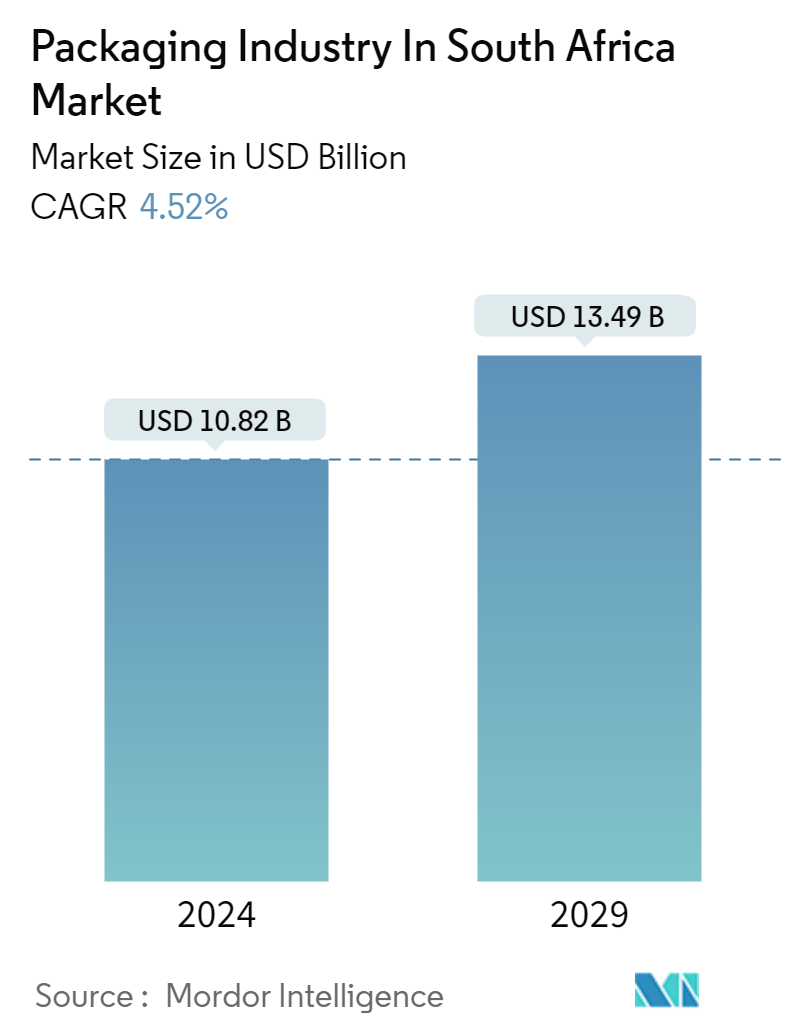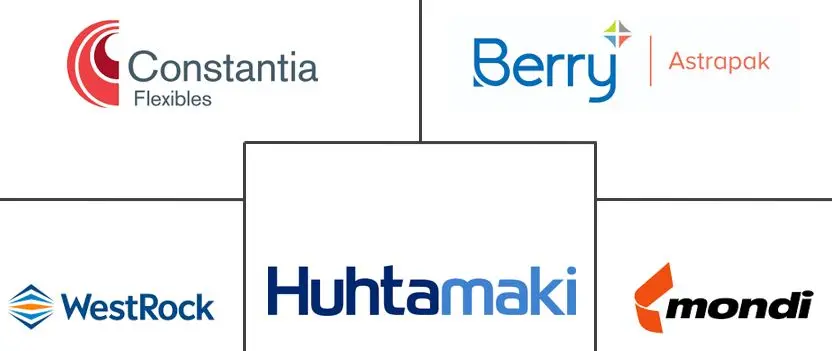Market Size of Packaging Industry In South Africa Industry

| Study Period | 2019 - 2029 |
| Base Year For Estimation | 2023 |
| Market Size (2024) | USD 10.82 Billion |
| Market Size (2029) | USD 13.49 Billion |
| CAGR (2024 - 2029) | 4.52 % |
| Market Concentration | Low |
Major Players
*Disclaimer: Major Players sorted in no particular order |
South Africa Packaging Market Analysis
The Packaging Industry In South Africa Market size is estimated at USD 10.82 billion in 2024, and is expected to reach USD 13.49 billion by 2029, growing at a CAGR of 4.52% during the forecast period (2024-2029).
- South Africa's market is witnessing momentum from a surge in young consumers, heightened consumer goods demand, and an expanding economy. The upswing in household disposable income, as reported by the South African Reserve Bank, underscores this trend. In the fiscal year 2022-23, households boasted an average disposable income of ZAR 50,500 (USD 2738), a slight uptick from the ZAR 50,000 (USD 2756.22) recorded in FY 2021-22.
- As urbanization and mobility surge in the country, the shift toward smaller and multipack offerings gains prominence. This trend offers manufacturers a chance to sway consumer brand loyalties and entice traders. The appeal lies in these products' space-saving nature and their knack for driving sales through eye-catching packaging.
- Urbanization's rapid pace and heightened health awareness have fueled a surge in the consumption of food, beverages (both alcoholic and non-alcoholic), and other products. This, in turn, has spurred a need for diverse packaging solutions, leading to notable shifts in the preference for glass containers and bottles. Data from Statistics South Africa reveals that the Consumer Price Index (CPI) for food and non-alcoholic beverages in South Africa stands at 111.1 points as of October 2023, marking a 5.2-point increase from the preceding year.
- However, the market’s growth is hindered by rising environmental concerns and a growing emphasis on recycling. Consequently, there is a rising demand for sustainable packaging solutions, especially as raw material prices for alternative packaging solutions continue to climb. This trend is pushing companies to innovate and develop eco-friendly packaging options to meet consumer expectations and regulatory requirements. The shift toward sustainability is influencing market dynamics, compelling businesses to adapt their strategies to remain competitive.
South Africa Packaging Industry Segmentation
The market is tracked based on the analysis of materials, products, and end-user industries, providing a detailed assessment of all types of packaging based on factors related to the different packaging product's demand and supply. The study also covers the packaging industry limited to South Africa and the vendors operating in the country.
The packaging market in South Africa is segmented by packaging material (plastic, paper and paperboard, metal, and glass), product (bottles, bags, and pouches, corrugated boxes, and metal cans), and end-user industry (food and beverage, household and personal care, pharmaceutical, and healthcare). The market sizes and forecasts are provided in terms of value (USD) for all the above segments.
| By Packaging Material | |
| Plastic | |
| Paper and Paperboard | |
| Metal | |
| Glass |
| By Product Type | |
| Bottles | |
| Bags and Pouches | |
| Corrugated Boxes | |
| Metal Cans | |
| Other Product Types |
| By End-user Industry | |
| Food and Beverage | |
| Household and Personal Care | |
| Pharmaceuticals and Healthcare | |
| Other End-user Industries |
Packaging Industry In South Africa Market Size Summary
The packaging industry in South Africa is poised for significant growth, driven by factors such as an increasing young consumer base, rising demand for consumer goods, and economic expansion. The market is experiencing a shift towards smaller and multipack solutions, influenced by urbanization and changing consumer lifestyles. This trend presents opportunities for manufacturers to encourage brand switching and optimize shelf space with attractive packaging. The demand for convenient food products and fresh food packaging is further bolstered by rising household disposable incomes. However, environmental concerns and the need for sustainable packaging solutions are becoming more prominent, impacting market dynamics. The COVID-19 pandemic has also disrupted the food supply chain, affecting packaging demand, but the market is gradually recovering with the easing of restrictions and a resurgence in retail sales.
The South African packaging market is characterized by its fragmentation, with numerous players vying for market share. Major companies are focusing on expanding their global customer base and enhancing profitability through strategic initiatives. The government's support for the food and beverage sector, along with innovations in sustainable packaging, is propelling market growth. Investments in new manufacturing facilities and technologies, such as those by Huhtamaki and Ardagh Glass Packaging, are expected to meet the rising demand for packaging solutions. The market is also witnessing a shift in consumer preferences towards premium and craft beverages, influencing packaging trends. As urbanization continues and family sizes decrease, space-efficient packaging solutions like carton packaging are gaining popularity, further driving market expansion.
Packaging Industry In South Africa Market Size - Table of Contents
-
1. MARKET INSIGHTS
-
1.1 Market Overview
-
1.2 Industry Value Chain Analysis
-
1.3 Industry Attractiveness - Porter's Five Forces Analysis
-
1.3.1 Threat of New Entrants
-
1.3.2 Bargaining Power of Buyers/Consumers
-
1.3.3 Bargaining Power of Suppliers
-
1.3.4 Threat of Substitute Products
-
1.3.5 Intensity of Competitive Rivalry
-
-
1.4 Assessment of Macroeconomic Factors on the Market
-
-
2. MARKET SEGMENTATION
-
2.1 By Packaging Material
-
2.1.1 Plastic
-
2.1.2 Paper and Paperboard
-
2.1.3 Metal
-
2.1.4 Glass
-
-
2.2 By Product Type
-
2.2.1 Bottles
-
2.2.2 Bags and Pouches
-
2.2.3 Corrugated Boxes
-
2.2.4 Metal Cans
-
2.2.5 Other Product Types
-
-
2.3 By End-user Industry
-
2.3.1 Food and Beverage
-
2.3.2 Household and Personal Care
-
2.3.3 Pharmaceuticals and Healthcare
-
2.3.4 Other End-user Industries
-
-
Packaging Industry In South Africa Market Size FAQs
How big is the Packaging Industry In South Africa Market?
The Packaging Industry In South Africa Market size is expected to reach USD 10.82 billion in 2024 and grow at a CAGR of 4.52% to reach USD 13.49 billion by 2029.
What is the current Packaging Industry In South Africa Market size?
In 2024, the Packaging Industry In South Africa Market size is expected to reach USD 10.82 billion.

